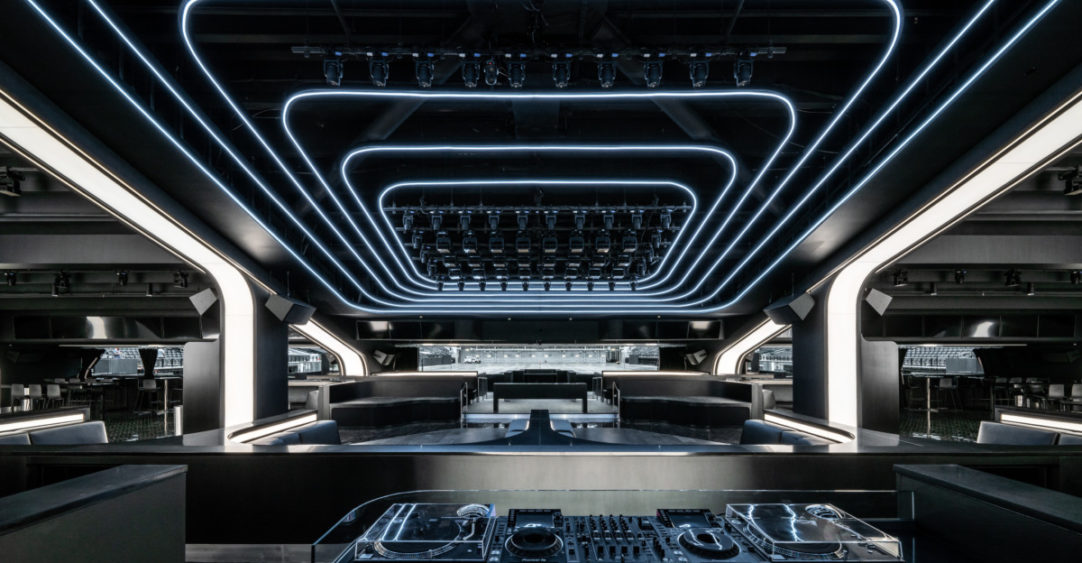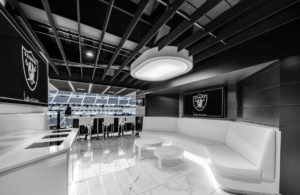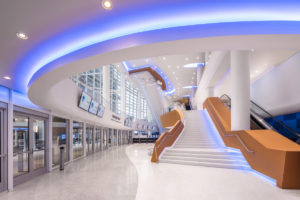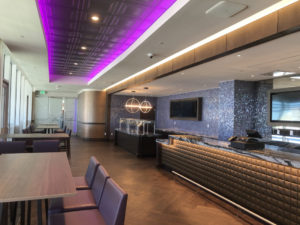
Networked Lighting Controls – Design Considerations with Integration in Mind
Sports and entertainment facilities need some of the most versatile controls when considering integration and operation of a building. Whether we’re talking about a stadium, arena, gaming space, or event space, controllability of lighting systems has many considerations when designing a new system or integrating into an existing one.
Today, energy codes provide a starting point and boundary of what to consider when designing these systems. For sports and entertainment facilities, there are event spaces that can have high intensity sports lighting or a high level of zones for DMX control, which is a digital communication protocol to remotely control intelligent light fixtures. Other areas are meeting rooms where controllability and scheduling become key. Suites, clubs, and concourse areas not only host fans during games, but can also be used more consistently for private events and business meetings that require flexibility.
 The Death Star in the desert, also known as Allegiant Stadium, is home to Raider Nation and the Las Vegas Raiders. The 65,000, expandable to 70,000 seat stadium is an NFL football venue first, but also year-round host to a variety of events, taking advantage of the multitude of assembly spaces throughout the facility from clubs, suites, meeting rooms, etc. As part of this prerequisite requirement or multi-use of club spaces for example, network level zoning controls for lighting make up a pivotal element of the flexibility in these spaces. Pre-programmed scene selections based on event type are an essential starting point that can then be modified on localized touch screens to the end user’s needs. Suites are another unique space that required forethought and were designed with the end user in mind. It is important to provide fans in the suites individual dimming control of fixtures in a modern stadium, while at the same time designing bowl-facing light fixtures on the networked system that allows for the stadium staff to uniformly control these fixtures. Stadium operators are also able to override local dimmed settings of each suite in order to create a more cohesive look throughout visible areas into the bowl, which becomes critical in concert blackout scenes or gameday player introductions.
The Death Star in the desert, also known as Allegiant Stadium, is home to Raider Nation and the Las Vegas Raiders. The 65,000, expandable to 70,000 seat stadium is an NFL football venue first, but also year-round host to a variety of events, taking advantage of the multitude of assembly spaces throughout the facility from clubs, suites, meeting rooms, etc. As part of this prerequisite requirement or multi-use of club spaces for example, network level zoning controls for lighting make up a pivotal element of the flexibility in these spaces. Pre-programmed scene selections based on event type are an essential starting point that can then be modified on localized touch screens to the end user’s needs. Suites are another unique space that required forethought and were designed with the end user in mind. It is important to provide fans in the suites individual dimming control of fixtures in a modern stadium, while at the same time designing bowl-facing light fixtures on the networked system that allows for the stadium staff to uniformly control these fixtures. Stadium operators are also able to override local dimmed settings of each suite in order to create a more cohesive look throughout visible areas into the bowl, which becomes critical in concert blackout scenes or gameday player introductions.
 The Chase Center in San Francisco is an 18,000 seat arena that created a focus on multi-event space for basketball, concerts, theater events with a fully integrated gantry grid, and so many other configurations. Add to that an open plaza with a 9,699 SF video board and color changing exterior lighting, a Gatehouse hosting retail amenities, and a sub grade parking garage, you have a host of zones and different systems that need to be integrated to seamlessly function together, while also providing customized control in each unique space. Consideration had to be taken into account on how the top layer of the system would tie together the different sub systems, even the ones with DMX controllability, and give the end user a powerful experience to change settings, schedules, and zones on the fly regardless of which sub system was affected. This centralized control must be user friendly to program and change on the fly for the constantly changing events that are occurring in the arena. To even further assist with these on the fly changes, all premium front of house areas were provided with individual IP addressable fixtures, which allows for the re-zoning of lighting control zones without the need to worry about how the fixtures are circuited within a space.
The Chase Center in San Francisco is an 18,000 seat arena that created a focus on multi-event space for basketball, concerts, theater events with a fully integrated gantry grid, and so many other configurations. Add to that an open plaza with a 9,699 SF video board and color changing exterior lighting, a Gatehouse hosting retail amenities, and a sub grade parking garage, you have a host of zones and different systems that need to be integrated to seamlessly function together, while also providing customized control in each unique space. Consideration had to be taken into account on how the top layer of the system would tie together the different sub systems, even the ones with DMX controllability, and give the end user a powerful experience to change settings, schedules, and zones on the fly regardless of which sub system was affected. This centralized control must be user friendly to program and change on the fly for the constantly changing events that are occurring in the arena. To even further assist with these on the fly changes, all premium front of house areas were provided with individual IP addressable fixtures, which allows for the re-zoning of lighting control zones without the need to worry about how the fixtures are circuited within a space.
![]()
 At TCU, the addition of the Legends Club and Suites to the east side of Amon G. Carter Stadium provided the opportunity to integrate a technology focused solution into the 75,000 SF addition that included new clubs, suites, loge boxes, cooking amenities, and so much more. We were part of the solution to design a system that pulled together control of the lighting, shade system, and operable glass. This maximized the fan experience while also allowing TCU Athletics the ability to program and schedule the spaces to be used in a variety of small and large events throughout the year, outside of football games. It was also necessary to join the controls of the system in with the existing stadium controls to provide one solution from an operations standpoint. All in all, the networked system was able to capture the vision that TCU Athletics had in mind for the space and integrate a solution to meet their collective needs.
At TCU, the addition of the Legends Club and Suites to the east side of Amon G. Carter Stadium provided the opportunity to integrate a technology focused solution into the 75,000 SF addition that included new clubs, suites, loge boxes, cooking amenities, and so much more. We were part of the solution to design a system that pulled together control of the lighting, shade system, and operable glass. This maximized the fan experience while also allowing TCU Athletics the ability to program and schedule the spaces to be used in a variety of small and large events throughout the year, outside of football games. It was also necessary to join the controls of the system in with the existing stadium controls to provide one solution from an operations standpoint. All in all, the networked system was able to capture the vision that TCU Athletics had in mind for the space and integrate a solution to meet their collective needs.
Networked lighting controls systems have evolved from being an afterthought to being a major contributor to the fan experience through flexibility of control, ease of programming and scheduling, and the added benefits of energy efficiency and savings. SSR provides a custom evaluation of those needs for every client and operator we partner with to provide a tailored approach that aligns with the mission and vision of their facility.








